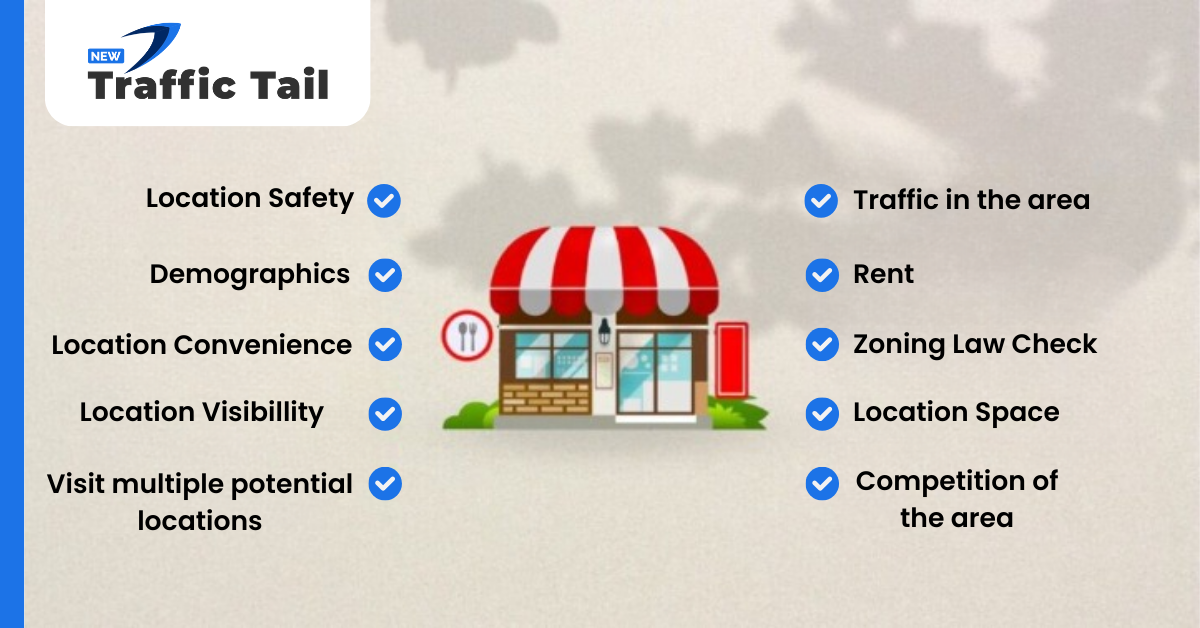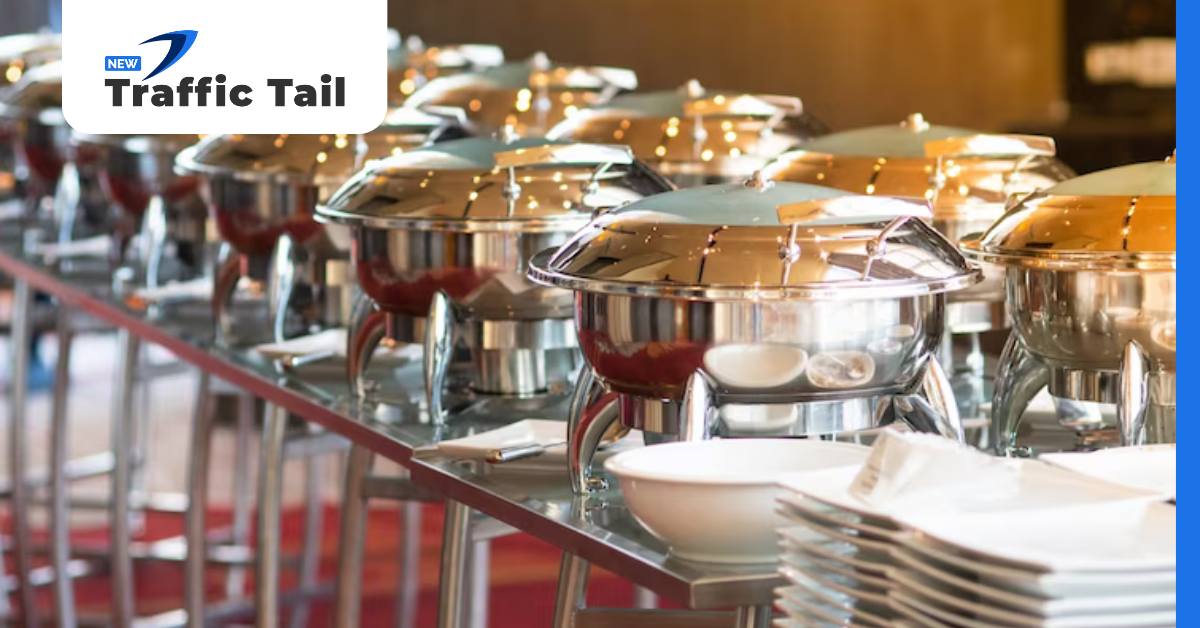Are you someone who loves to cook food and wants to turn this passion into a thriving catering business? If yes, so this is the starting point for a fascinating adventure into the world of catering.
I know it is complicated since you need a lot of capital, manpower, place, and other things. Also, the thought of competition keeps rolling in your mind. But if you believe that your food has power that can create word-of-mouth marketing, so get into it.
Whether you are an experienced chef or a homemaker, this ultimate guide on how to start a catering business will delve into the industry scope, innovative strategies, and practical insights that help you establish a powerful catering business from home in the competitive market.
Ready? Let’s get going!

Decide On-site Catering Vs. Off-site Catering
Within the catering industry, there are two unique approaches: on-site catering and off-site catering. Each has advantages and considerations of its own. Knowing the distinctions between them will enable you to select the best model for your catering business.
On-site Catering: Running an on-site catering business involves preparing and serving food at the same location where the event is taking place. For example, a wedding venue or hotel.
Off-site Catering: Off-site catering business involves preparing food in a kitchen and taking it off to another place for serving. For example, home-based cooking or catering service.
So, starting a catering business from home, you might be able to use both of these strategies. For example, you may prepare everything at home and transport it all to the event site for plating and cooking at the end. Another option is to prepare everything in your home kitchen and then bring the finished dishes to the event.
Remember, the method you choose, requires a thorough study because state and local culinary restrictions may have an impact on the approach you select.
10 Steps How to Start a Catering Business from Home
Let’s start our exciting learning journey on how to start a catering business from home. Here I have explained the 10 steps that will assist you in what to do next.
Step 1: Understand Your Area of Expertise
To scale your catering business, it is crucial to focus on your expertise first. However, if you are unsure about your business niche, you can ask for help or a business advisor who has experience in the food industry and can understand your position easily.
Here are a few questions you should ask yourself:
- What type of food do you want to serve be it Chinese, Indian, or others?
- Is your food for everyone or targeting specific customers, such as diabetic or High BP patients?
- What type of events you can handle- corporate parties or homely get-togethers?
- What is your capacity to serve people a day- 100, 200, or more?
- Who’s going to cook, market, manage sales, and do other activities?
- Who is your competition and what’s your plan to compete with him?
- Does your food have special ingredients or same as your competitor’s?
When you have clear answers to all the above questions, you’re ready to start a successful catering business.
Step 2: Perform Market Analysis
Before a catering business starts, you must understand your audience, competition, and the catering industry to run a profitable business. Therefore, look for the specialty foods in your area and what the needs of the clientele are when hiring a caterer.
Check out the menus and size functions that your rivals are serving. If their websites don’t list approximate costs, you might want to phone and ask for quotations. Moreover, speaking with their clients is the finest technique to find out more about nearby caterers after that.
In addition to learning the ins and outs of what your rivals are doing—good or bad—you will also be gathering consumer insights. This will assist you in making future business marketing plans.
Here are a few ideas to get you started with in-depth market research:
- Ask your friends and family about their catering experience, this will assist you to plan what kinds of services you need to work on to make your customers extremely happy.
- Read your competitor reviews, you can find the ins and outs of that cater and you can create a master business plan to serve your clients the best.
- Look out the catering business trends to understand how the market is performing, what’s new and outdated in the market, factors to work on, and lots more.

Step 3: Make a List of Local License and Permits
Depending on your state, the licensing and permits for catering companies may vary. Under the permits, you may not allowed to prepare food for your customers that you used to prepare your meal. So, check on all guidelines before starting a catering business from home and avoid further losses. And if you want to serve liquor, there are other legal requirements you need to follow.
Here I am sharing a few licenses that are common in every state:
- General business license: allows you to engage in business activities in the local area.
- DBA registration: depending on your state, register a DBA before operating your catering business under a name other than your legal name.
- EIN: works as your Tax ID and allows you to pay taxes.
- Home occupation permit: allows you to establish a catering business from your home.
- Caterer Permit: depending on your county and state, there can be special caterer permission that differs from the typical food handler permit or food safety certification.
- Health Permits: based on the location of the food preparation and if it will be transported.
Pro Tip: To find out what licenses and permissions apply to you, get in contact with your Secretary of State and your local health authority.
Step 4: Create an Attractive Food Menu
Now that you have understood the importance of market research and the local licenses you need to look upon, your next step is to prepare an attractive food menu. It is ideal to begin with a predetermined list of possibilities, even though you can customize it afterward. In this manner, you can order supplies prepare each dish well in advance, and serve it to your guests.
After buyers select their things, it’s merely a matter of combining the elements you’ve previously determined. Your culinary facilities and capacity will determine your menu. Less obviously, the kinds of meals you feel comfortable offering and the target market you’re promoting to will have an impact.
For example, your winter menu won’t include freshly squeezed orange juice if you exclusively serve food made with seasonal, local products.

Step 5: Arrange Funds
Now, the financial journey begins! For a catering business start-up, you need capital whether you’re starting from home or on-site. Here you need to figure out your funding source and budget. Before a new firm may begin to turn a profit, it must have enough cash to survive. Consequently, one of the most crucial actions a catering company needs to perform to succeed is creating a financial plan.
Although each business has different capital requirements, market trends indicate that you will need about 20 lakhs. This covers things like license applications, business costs, rent, and pay for employees, etc.
And if you’re wondering how to pay for this, we suggest looking into business loans as a possibility. Your goal of opening your own catering company can now come true with affordable borrowing rates and a simple application procedure.
Step 6: Decide Your Business Location
Well, if you are starting a catering business from home you may say your job location will be your kitchen or your backyard. But hold on! In some states, you might not be able to cook at home. If that’s the case, you can either cook on-site or rent a professional kitchen.
Although renting a commercial kitchen raises your operational expenses, it also offers you flexibility because you can always make meals for your clients, no matter where they are. Additionally, you’ll be able to accomplish more than you could at home. But you’ll also be handling food delivery, so you’ll need equipment and cars that can handle the task.
The ideal catering business strategy is to decide what and to whom you will serve, then pick a suitable site and create a budget.

Step 7: Shop for the Equipment
A catering company’s kitchen is the center of operations. Thus, the equipment and appliances needed for its efficient operation must also be purchased. This covers both large-ticket items like ovens, stoves, fryers, and refrigerators as well as smaller appliances like pots, pans, spatulas, etc.

Step 8: Give Your Catering Business a Unique Name
There is no need to give a name to your business until you don’t want to market it. For the registration, getting a license, and preparing a business structure you need a name. You can choose any name of your choice, there are no limitations.
I recommend you select a name that reflects your business specialties and makes you visible in the market easily.
Step 9: Select a Cost-Effective Marketing Plan for Your Catering Company
Starting a catering business is easy but keeping it running successfully is a challenging job, especially when you have high competition. Therefore, you need to work on a strong marketing strategy that helps you have customers always.
In that case, follow the given tips to run a successful catering business:
- Maintain the quality and taste of your food.
- Deliver outstanding customer service, for example, quick delivery, fresh food, etc.
- Utilize marketing techniques such as giving discounts, weekly offers, and best deals of the day.
Step 10: Start your Catering Venture
Now, you are all set to start your catering business from home! This involves getting the word out and attracting the attention of your target market to your firm. This can be accomplished by networking, sharing content on social media, sending emails with early bird discounts, or even setting up booths to give out food samples.
The goal is to attract customers and raise brand awareness. Thus, be sure that your marketing initiatives are worthwhile!

How Profitable Is Your Catering Business From Home?
If you have decided to start a catering business from home, then you may interested to know about the profits you can make. A home-based catering business’s profitability can vary depending on several factors, such as its target market, location, pricing strategy, and operational efficiency.
Although running a home-based catering business can save costs, there are a few factors to take into account that could affect your total profitability. Here we go:
- When compared to renting a commercial kitchen or other specialized area, operating from home can result in much lower overhead expenditures. Rent, utility, and other facility-related costs can be reduced easily.
- Some of the essential kitchenware may already be in your home, which can reduce the cost of the initial purchase. But, the size of your business may require you to make extra equipment purchases.
- Profitability may be influenced by the local demand for catering services. Increased income may result from a high demand for catering services, particularly for occasions like weddings, business get-togethers, and private parties.
- Your profit margin may be greatly impacted by the volume and type of events you serve. Higher attendance and more elaborate events might boost income, but you must be sure your staff and kitchen can handle the strain.
- Maintaining profitable and competitive prices is essential. When deciding on your pricing plan, take into account variables such as labor, overhead, market rates, and ingredient costs.
- Higher profitability is a result of efficient culinary operations and good time management. Reducing waste, refining recipes, and streamlining procedures can all help your bottom line.
- Verify that local health and safety laws are being followed. To run a home-based catering service, you might require licenses and permits depending on where you live. The expense of acquiring these can affect your business’s profitability.
Closing Thoughts
This is all I can say on how to start a catering business from home. I hope this post has helped you understand powerful insights that you may need before starting up your business.
Catering business involves meticulous preparation, commitment, and close attention to detail. However, one must keep in mind that providing outstanding service and continuously going above and beyond for customers is often the key to success in the catering industry. So, follow the guidelines and make your catering business a huge success. However, if you still have any questions in your mind, comment to us.
Additional Readings:
Frequently Asked Questions
Q1. What is the budget for a catering business?
The cost of launching a catering company can differ significantly based on several variables, including the operation’s size, location, menu selections, and equipment needs. However, on average, 20 lakhs is required to make an initial step.
Q2. What is the easiest and most profitable food to sell?
The easiest and most highly profitable foods to sell are toast, grilled sandwiches, burgers, noodles, pasta, pizza, dal makhani, roti, paneer, salads, cookies, and nachos.
Q3. What is the license for selling homemade food in India?
FSSAI (Functions under the Administrative Control of Health and Family Welfare) is an essential food license to run any food business in India. Depending on the state there are more licenses you need to file such as general business, health permits, etc.
Q4. What is the difference between hotel and catering industry?
The hotel industry is solely concerned with producing guest accommodation and food service, whereas catering industries are concerned with delivering delicious food on-site and off-site.




